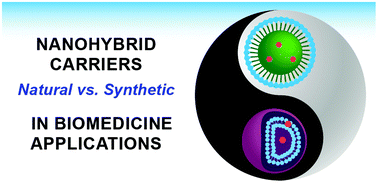Nanohybrid carriers: the yin–yang equilibrium between natural and synthetic in biomedicine
Abstract
Nanotechnology has seen an outburst in biomedicine applications through the use of nanoparticles of different sources in therapy and diagnostics. The needs of theranostics evolved through the years for the development of tailored treatments. In this regard, nanocarriers have shown a great impact on the field via the use of natural lipidic vesicles for drug delivery. This breakthrough allowed the medical field to protect the drug from undesired interactions in the bloodstream and lowered the drug load usually given to reach therapeutical doses. Nanocarriers further continued by using block polymers to create more stable structures with higher protection levels of their content. In this review, we introduce both lipidic and polymeric vesicles with their specific characteristics and discuss the advantages and disadvantages of each type which was taken as a base to introduce the newly known lipid–polymer hybrids that take the advantages from both sides to present an interesting approach to regulate the physicochemical features, pharmacokinetics and other parameters used in tailoring treatments for cancer therapy. In addition, from the many hybrids proposed we have focused our efforts in discussing two major groups that are lipid–polymer hybrid nanoparticles LPHNs (polymersomes inside liposomes), and capsosomes (liposomes inside polymersomes) showing the many potential benefits of combining lipids and polymers for biomedicine.



 Please wait while we load your content...
Please wait while we load your content...